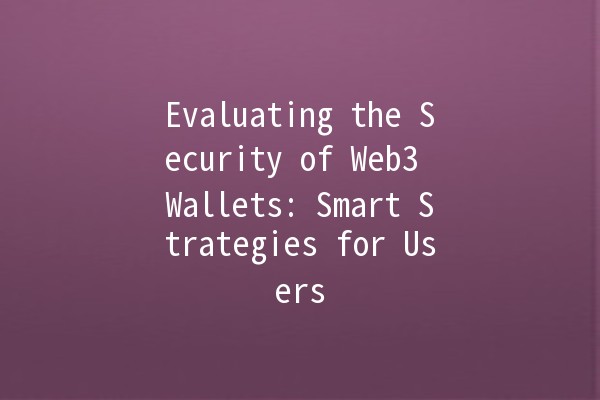
In the rapidly evolving digital landscape, the rise of Web3 technology has introduced numerous innovations—one of the most significant being Web3 wallets. These wallets are pivotal in managing digital assets, facilitating transactions, and interacting within decentralized applications (dApps). However, with great power comes great responsibility, especially concerning security. Evaluating the security of a Web3 wallet isn't merely about understanding its features; it involves a comprehensive approach that considers design, vulnerabilities, and best practices.
Understanding Web3 Wallets and Their Importance
Web3 wallets serve as digital vaults, allowing users to store cryptocurrencies and collect tokens while enabling interaction with various dApps and maintaining control over private keys. Unlike traditional wallets, Web3 wallets promote decentralized control, letting users manage their funds directly without reliance on centralized institutions. As appealing as this may sound, the decentralization factor introduces unique risks that require thorough evaluation.
Factors to Consider When Evaluating Security
Custodial Wallets: These are managed by thirdparty services, meaning users give up control of their private keys. While this reduces the burden on users, it creates a risk as the thirdparty can be compromised.
NonCustodial Wallets: Users maintain total control over their private keys, enhancing security if the wallet is welldesigned. However, the user is solely responsible for their security, increasing the stakes.

Strong key management practices are essential. Users should ensure that their private keys are stored securely and never shared. Using hardware wallets can significantly enhance security.
Evaluate the security features each wallet provides. Look for features such as twofactor authentication (2FA), biometric access, multisignature support, and automatic backup options.
Opensource wallets allow the community to audit the code for vulnerabilities, increasing transparency. Wallets that are closedsource may hide potential risks.
Research the wallet's track record. Look for reviews, user feedback, and whether it has had any major security breaches in the past.
Practical Security Improvement Techniques
To ensure your Web3 wallet remains secure, consider employing the following techniques:
Keeping your wallet software updated is crucial. Developers routinely patch vulnerabilities and incorporate new security protocols. Failing to do so can expose users to known threats.
Example: If a wallet provider releases an update that enhances encryption measures, install it promptly, ensuring your funds remain protected against theft.
Utilizing 2FA adds an additional layer of security to your wallet. Even if your password is compromised, a second verification step can prevent unauthorized access.
Example: If you log in to your Web3 wallet, you’ll receive a text message or an authentication app code, providing an extra hurdle for potential attackers.
For users storing significant assets, hardware wallets such as Ledger or Trezor provide unparalleled security by keeping private keys offline.
Example: Instead of keeping your cryptocurrency in a software wallet, transfer it into a hardware wallet to protect it from online threats.
Phishing is a prevalent tactic used by attackers. Users must remain vigilant, verifying URLs and never clicking on suspicious links.
Example: Always type the wallet’s URL directly into your browser instead of clicking on links in emails or social media.
Regularly backing up your wallet is essential. Ensure you have safe copies of recovery phrases or seed phrases stored in secure physical locations.
Example: Store your backup outside your home, such as in a safe deposit box, to mitigate loss in case of theft or fire.
Common Questions About Web3 Wallet Security
What is the main difference between custodial and noncustodial wallets?
Custodial wallets are managed by a third party, meaning the provider controls the private keys, while noncustodial wallets give users full control of their keys. This distinction is crucial, as it impacts user autonomy and security levels.
How can I avoid phishing scams while using a Web3 wallet?
To prevent phishing scams, always verify website URLs, avoid sharing personal information, and look for secure connections (HTTPS). Additionally, consider using a dedicated walletonly device to minimize exposure to potential threats.
What should I do if my wallet is compromised?
If you discover that your wallet has been compromised, immediately transfer your assets to a secure wallet, change passwords, and enable 2FA on all accounts linked to the compromised wallet. Reporting the incident to the service provider can also assist in tracking the breach.
Are Web3 wallets really secure?
Web3 wallets can be secure if users adopt best practices. The security of a wallet often hinges on the user's actions, such as managing private keys and recognizing threats in the digital landscape.
How often should I update my wallet software?
Wallet providers should notify you of updates, and it’s best practice to update whenever a new version is released. Frequent updates typically indicate ongoing security improvements and enhancements.
Can I recover my assets if I lose my wallet?
If you lose access to your wallet but have a backup of your seed phrase or recovery keys, you can restore your wallet and retrieve your assets. Without these backups, however, recovery is unlikely.
Staying Ahead of Threats
As Web3 wallets become more integral to the digital economy, ensuring their security is paramount for all users. The interplay between innovation and security necessitates an ongoing commitment to best practices. Regular evaluations of wallet features, attentiveness to security updates, and mindfulness around potential threats can significantly enhance your digital asset security.
: Awareness is Key
In today’s fastpaced digital environment, the responsibility rests on individuals to grasp the importance of securing their Web3 wallets. By understanding the various security features, employing practical strategies, and remaining vigilant against evolving threats, users can navigate the Web3 landscape confidently and securely. The journey of leveraging decentralized finance begins with a secure gateway, and investing time to evaluate wallet security provides not just peace of mind but also protection for your digital assets.

